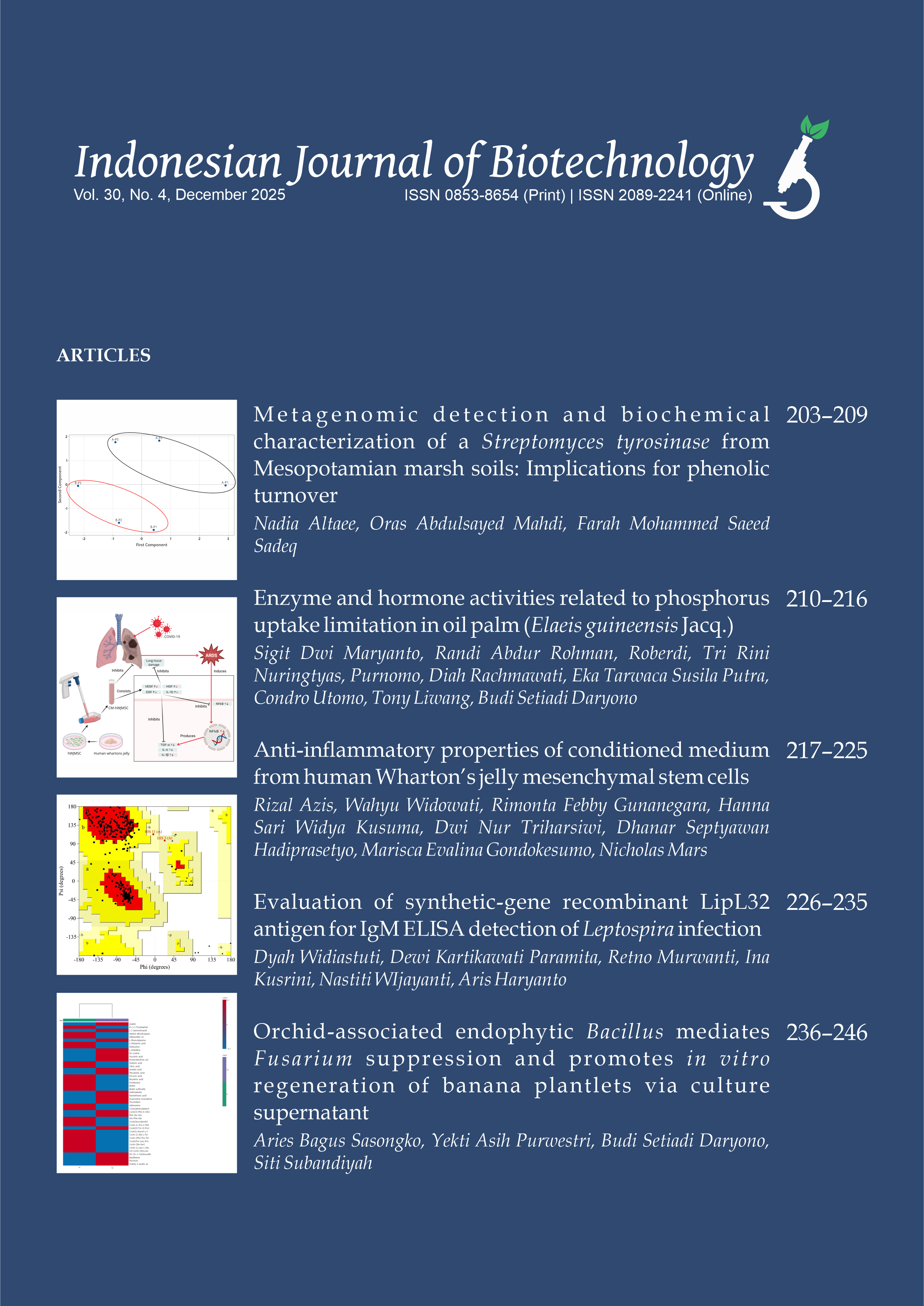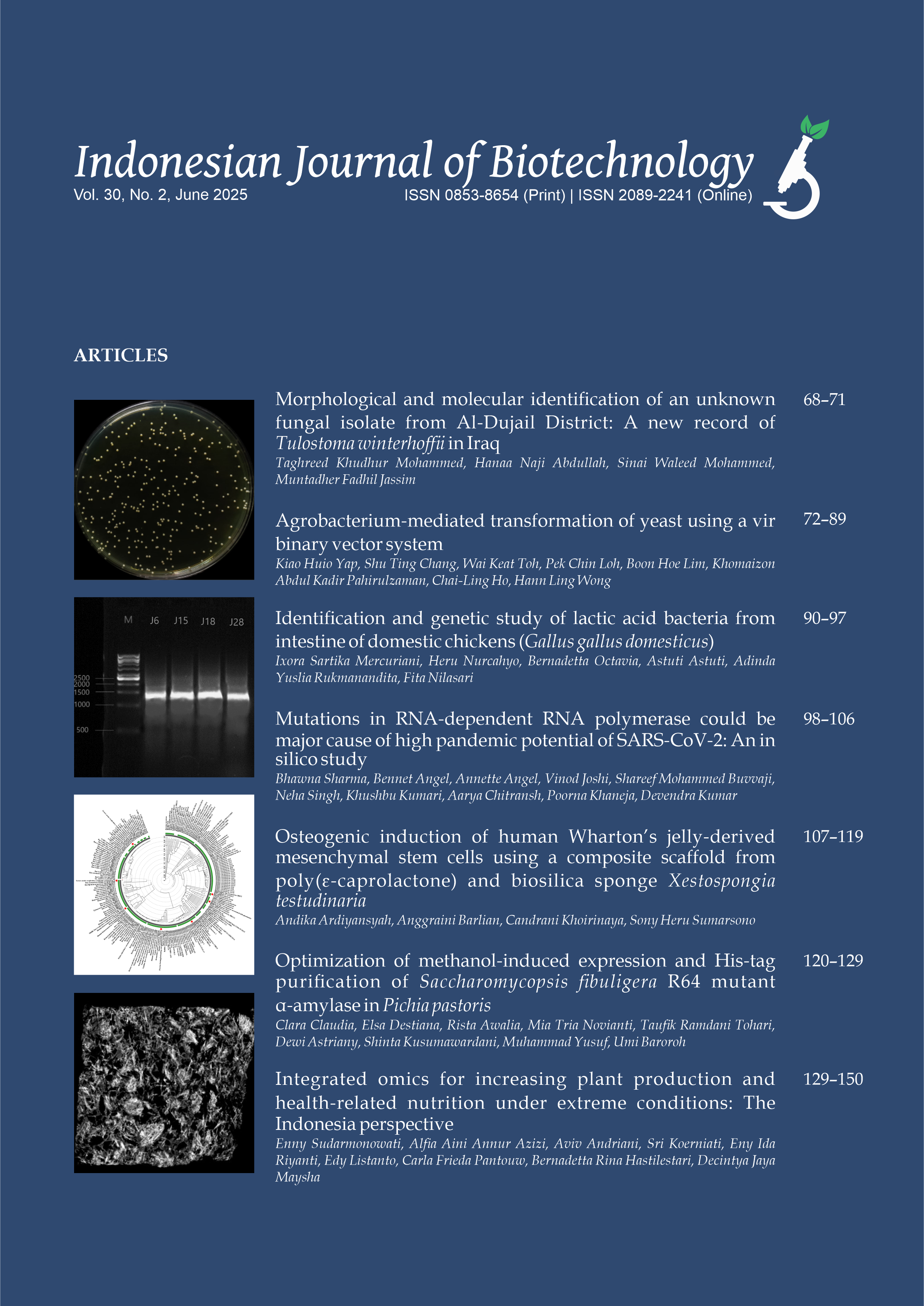Bovine vitreous gel can reactivate replicative senescence of human dermal fibroblast
Maria Vianny Sansan(1), Sunardi Radiono(2), Muhamad Eko Irawanto(3), Yohanes Widodo Wirohadidjojo(4*)
(1) Department of Dermatology and Venereology, Faculty of Medicine, Universitas Gadjah Mada and Dr. Sardjito General Hospital, Yogyakarta
(2) Department of Dermatology and Venereology, Faculty of Medicine, Universitas Gadjah Mada and Dr. Sardjito General Hospital, Yogyakarta
(3) Department of Dermatology and Venereology, Faculty of Medicine, Sebelas Maret University and Dr. Moewardi General Hospital, Surakarta
(4) Department of Dermatology and Venereology, Faculty of Medicine, Universitas Gadjah Mada and Dr. Sardjito General Hospital, Yogyakarta
(*) Corresponding Author
Abstract
Keywords
Full Text:
Sansan et al.References
Alcorta DA, Xiong Y, Phelps D, Hannon G, Beach D, Barrett JC. 1996. Involvement of the cyclin-dependent kinase inhibitor p16 (INK4a) in replicative senescence of normal human fibroblasts. Proceedings of the National Academy of Sciences of the United States of America 93:13742–13747.
Almqvist S, Werthén M, Johansson A, Törnqvist J, Agren MS, Thomsen P. 2009. Evaluation of a near-senescent human dermal fibroblast cell line and effect of amelogenin. British Journal of Dermatology 160:1163–1171. doi:10.1111/j.1365-2133.2009.09071.x.
Brem H, Golinko MS, Stojadinovic O, Kodra A, Diegelmann RF, Vukelic S, Entero H, Coppock DL, Tomic-Canic M. 2008. Primary cultured fibroblasts derived from patients with chronic wounds: a methodology to produce human cell lines and test putative growth factor therapy such as GMCSF. Journal of Translational Medicine 6:75. doi:10.1186/1479-5876-6-75.
Chia HY, Tang MBY. 2014. Chronic leg ulcers in adult patients with rheumatological diseases - a 7-year retrospective review. International Wound Journal 11:601–604. doi:10.1111/iwj.12012.
Courty J, Chevallier B, Moenner M, Loret C, Lagente O, Bohlen P, Courtois Y, Barritault D. 1986. Evidence for FGF-like growth factor in adult bovine retina: analogies with EDGF I. Biochemical and Biophysical Research Communications 136:102–108. doi:10.1016/0006-291X(86)90882-X.
Cowin AJ, Hatzirodos N, Holding CA, Dunaiski V, Harries RH, Rayner TE, Fitridge R, Cooter RD, Schultz GS, Belford DA. 2001. Effect of healing on the expression of transforming growth factor beta(s) and their receptors in chronic venous leg ulcers. Journal of Investigative Dermatology 117:1282–1289. doi:10.1046/j.0022-202x.2001.01501.x.
Eckes B, Zweers MC, Zhang ZG, Hallinger R, Mauch C, Aumailley M, Krieg T. 2006. Mechanical tension and integrin alpha 2 beta 1 regulate fibroblast functions. Journal of Investigative Dermatology 11:66–72.
Harding KG, Moore K, Phillips TJ. 2005. Wound chronicity and fibroblast senescence--implications for treatment. Int Wound J. 2:364–368. doi:10.1111/j.1742-4801.2005.00149.x.
Kim B-C, Kim HT, Park SH, Cha J-S, Yufit T, Kim S-J, Falanga V. 2003. Fibroblasts from chronic wounds show altered TGF-beta-signaling and decreased TGF-beta Type II receptor expression. Journal of Cellular Physiology 195:331–336. doi:10.1002/jcp.10301.
Liang C-C, Park AY, Guan J-L. 2007. In vitro scratch assay: a convenient and inexpensive method for analysis of cell migration in vitro. Nature Protocols 2:329–333. doi:10.1038/nprot.2007.30.
McCarty SM, Cochrane CA, Clegg PD, Percival SL. 2012. The role of endogenous and exogenous enzymes in chronic wounds: a focus on the implications of aberrant levels of both host and bacterial proteases in wound healing. Wound Repair and Regeneration 20:125–136. doi:10.1111/j.1524-475X.2012.00763.x.
Mendez MV, Stanley A, Park HY, Shon K, Phillips T, Menzoian JO. 1998. Fibroblasts cultured from venous ulcers display cellular characteristics of senescence. Journal of Vascular Surgery 28:876–883.
Motolese A, Vignati F, Brambilla R, Cerati M, Passi A. 2013. Interaction between a regenerative matrix and wound bed in nonhealing ulcers: results with 16 cases. BioMed Research International 2013:849321. doi:10.1155/2013/849321.
Quan T, Wang F, Shao Y, Rittié L, Xia W, Orringer JS, Voorhees JJ, Fisher GJ. 2013. Enhancing structural support of the dermal microenvironment activates fibroblasts, endothelial cells, and keratinocytes in aged human skin in vivo. Journal of Investigative Dermatology 133:658–667. doi:10.1038/jid.2012.364.
Shiedlin A, Bigelow R, Christopher W, Arbabi S, Yang L, Maier RV, Wainwright N, Childs A, Miller RJ. 2004. Evaluation of hyaluronan from different sources: Streptococcus zooepidemicus, rooster comb, bovine vitreous, and human umbilical cord. Biomacromolecules 5:2122–2127. doi:10.1021/bm0498427.
Stanley A, Osler T. 2001. Senescence and the healing rates of venous ulcers. Journal of Vascular Surgery 33:1206–1211. doi:10.1067/mva.2001.115379.
Theocharis DA, Skandalis SS, Noulas AV, Papageorgakopoulou N, Theocharis AD, Karamanos NK. 2008. Hyaluronan and chondroitin sulfate proteoglycans in the supramolecular organization of the mammalian vitreous body. Connective Tissue Research 49:124–128. doi:10.1080/03008200802148496.
Trent JT, Falabella A, Eaglstein WH, Kirsner RS. 2005. Venous ulcers: pathophysiology and treatment options. Ostomy/Wound Management 51:38-54
Wall IB, Moseley R, Baird DM, Kipling D, Giles P, Laffafian I, Price PE, Thomas DW, Stephens P. 2008. Fibroblast dysfunction is a key factor in the non-healing of chronic venous leg ulcers. Journal of Investigative Dermatology 128:2526–2540. doi:10.1038/jid.2008.114.
Yager DR, Chen SM, Ward SI, Olutoye OO, Diegelmann RF, Kelman Cohen I. 1997. Ability of chronic wound fluids to degrade peptide growth factors is associated with increased levels of elastase activity and diminished levels of proteinase inhibitors. Wound Repair and Regeneration 5:23–32. doi:10.1046/j.1524-475X.1997.50108.x.
Yarrow JC, Perlman ZE, Westwood NJ, Mitchison TJ. 2004. A high-throughput cell migration assay using scratch wound healing, a comparison of image-based readout methods. BMC Biotechnology 4:21. doi:10.1186/1472-6750-4-21.
Yercan H, Kutay FZ. 1999. Quantification of total collagen in rabbit tendon by the Sirius Red Method. Turkish Journal of Medical Sciences 29:7--9.
Article Metrics
Refbacks
- There are currently no refbacks.
Copyright (c) 2018 The Author(s)

This work is licensed under a Creative Commons Attribution-ShareAlike 4.0 International License.









